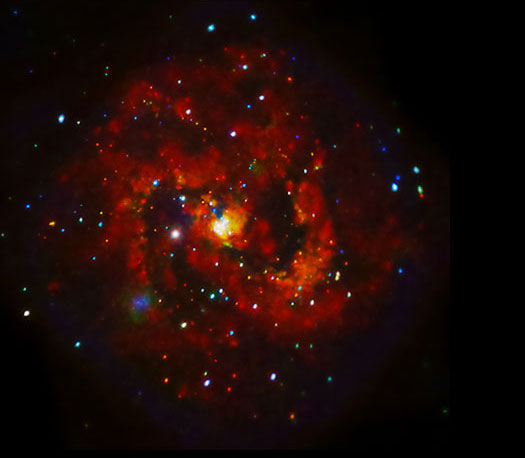Named SN 1957D because it was the fourth supernova to be discovered in the year of 1957, it is one of only a few located outside of the Milky Way galaxy that is detectable, in both radio and optical wavelengths, decades after its explosion was observed. In 1981, astronomers saw the remnant of the exploded star in radio waves, and then in 1987 they detected the remnant at optical wavelengths, years after the light from the explosion itself became undetectable.

A relatively short observation — about 14 hours long — from NASA's Chandra X-ray Observatory in 2000 and 2001 did not detect any X-rays from the remnant of SN 1957D. However, a much longer observation obtained in 2010 and 2011, totaling nearly 8 and 1/2 days of Chandra time, did reveal the presence of X-ray emission. The X-ray brightness in 2000 and 2001 was about the same as or lower than in this deep image.
This new Chandra image of M83 is one of the deepest X-ray observations ever made of a spiral galaxy beyond our own. This full-field view of the spiral galaxy shows the low, medium, and high-energy X-rays observed by Chandra in red, green, and blue respectively. The location of SN 1957D, which is found on the inner edge of the spiral arm just above the galaxy's center, is outlined in the box.

The new X-ray data from the remnant of SN 1957D provide important information about the nature of this explosion that astronomers think happened when a massive star ran out of fuel and collapsed. The distribution of X-rays with energy suggests that SN 1957D contains a neutron star, a rapidly spinning, dense star formed when the core of pre-supernova star collapsed. This neutron star, or pulsar, may be producing a cocoon of charged particles moving at close to the speed of light known as a pulsar wind nebula.
If this interpretation is confirmed, the pulsar in SN 1957D is observed at an age of 55 years, one of the youngest pulsars ever seen. The remnant of SN 1979C in the galaxy M100 contains another candidate for the youngest pulsar, but astronomers are still unsure whether there is a black hole or a pulsar at the center of SN 1979C.
These results will appear in an upcoming issue of The Astrophysical Journal. The researchers involved with this study were Knox Long (Space Telescope Science Institute), William Blair (Johns Hopkins University), Leith Godfrey (Curtain University, Australia), Kip Kuntz (Johns Hopkins), Paul Plucinsky (Harvard-Smithsonian Center for Astrophysics), Roberto Soria (Curtain University), Christopher Stockdale (University of Oklahoma and the Australian Astronomical Observatory), Bradley Whitmore (Space Telescope Science Institute), and Frank Winkler (Middlebury College).
NASA's Marshall Space Flight Center in Huntsville, Ala., manages the Chandra program for NASA's Science Mission Directorate in Washington. The Smithsonian Astrophysical Observatory controls Chandra's science and flight operations from Cambridge, Mass.
| Fast Facts for SN 1957D in M83: | |
| Credit | X-ray: NASA/CXC/STScI/K.Long et al., Optical: NASA/STScI |
| Release Date | July 30, 2012 |
| Scale | 9.5 arcmin on a side (~41,000 light years); Inset image: 1.6 x 1.3 arcsec (~120 x ~100 light years) |
| Category | Normal Galaxies & Starburst Galaxies |
| Coordinates (J2000) | RA 13h 37m 00.80s | Dec -29 51 58.60 |
| Constellation | Hydra |
| Observation Date | 12 pointings between April 29, 2000 and Dec 28, 2011 |
| Observation Time | 219 hours 49 min. |
| Obs. ID | 793, 2064, 12420, 12992-12996, 13202, 13241, 13248, 14332, 14342 |
| Instrument | ACIS |
| Also Known As | NGC 5236 |
| References | Long, K. et al, 2012, (in press) arXiv:1207.1555 |
| Color Code | X-ray: (Red, Green, Blue); Optical inset (Red, Green, Blue) |
  |
| Distance Estimate | 15 million light years |
› Read more/access all images
› Chandra's Flickr photoset
Contacts and sources:
Janet Anderson, 256-544-0034
Marshall Space Flight Center, Huntsville, Ala.
[email protected]
Megan Watzke 617-496-7998
Chandra X-ray Center, Cambridge, Mass.
[email protected]






